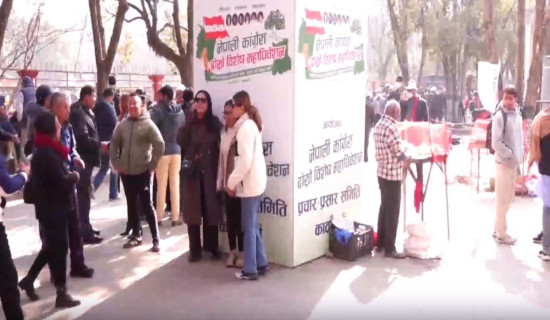- Wednesday, 14 January 2026
Pursuing People-centric Development Model
Population is central to sustainable development. In many developing countries, the diverse issues of population and sustainable development are considered in the national development policies and strategies. In 1994, International Conference on Population and Development (ICPD) held in Cairo made a clear articulation of population and development agenda more profoundly by placing people’s dignity and rights at the heart of sustainable development. More recently, Seventh Asian and Pacific Population Conference was convened by the United Nations Economic and Social Commission for Asia and the Pacific (UNESCAP) in collaboration with United Nations Population Fund (UNFPA) in Bangkok, Thailand. In this important conference, Nepal also presented the overall progress of the ICPD commitments and priorities in the federal context.
The Asia and Pacific region is home to 60 per cent of the world’s population. Among many others, the region has been undergoing a momentous transition from high to low fertility and mortality levels. There is considerable progress in terms of health, poverty eradication, sanitation, nutrition, education and overall socio-economic development. However, the socio-economic inequalities across the region have been exacerbated by climate change, disasters, conflicts and the COVID-19 pandemic.
People-centred approach
Like many other countries, Nepal also adopted the key agenda and priorities of the ICPD at large. These largely include promoting people-centred approach in development, human rights, empowering women and girls, reproductive health rights, and addressing socio-cultural, economic, geographic and political inequalities. Despite some remarkable gains in health and population sector, the progress is still minimal.
During Nairobi Summit in 2019, Nepal committed to achieving zero unmet need for family planning, zero preventable maternal deaths, and zero gender-based violence including harmful practices. Other areas of the commitments include investing in young people including their health and well-being by ensuring their sexual and reproductive health rights. There is increasing focus to scale up and strengthen adolescent friendly services and comprehensive sexuality education. Additionally, there are critical needs to ensure basic humanitarian needs of poor and socially marginalised populations and affected families. These include sexual and reproductive health care, gender-based violence prevention and response in the humanitarian context.
More importantly, there are emerging priorities of adequate financing policies, instruments and structures to ensure effective implementation of the ICPD priorities in the federal context. According to National Housing and Population Census 2021, Nepal’s population is 29.2 million. The growth rate has declined steadily from 2.3 per cent in 2001 to 0.9 per cent in 2021. The evidence suggests that there is a declining fertility rate and an increase in migration abroad. Maternal mortality is still high in Nepal. Two women die every day due to pregnancy or child birth related complications. Most of these deaths are preventable. About 56 per cent of deaths occur in health facilities, 26 per cent occur at home, and 17 per cent occur on the way to health facilities.
According to the 2021 census data, maternal mortality rates have substantially reduced, from 281 to 151 maternal deaths per 100,000 live births between 2006 and 2021. Additionally, the use of modern contraceptives increased from 26 percent in 1996 to 43 per cent, while adolescent fertility rates decreased from 127 to 71, and the total fertility rate declined from 4.6 to 2.1 between 1996 and 2022.
In this context, Ministry of Health and Population (MoHP) convened a series of participatory and inclusive consultations with a range of stakeholders from the governments, civil society, media, parliamentarians, youth, migrants, sexual and gender minorities, and people with disability to review the progress of the ICPD commitments and identify new priorities for actions at local level. These consultations provided an important opportunity to discuss key issues, gaps and challenges experienced during the implementation of the ICPD priorities and commitments at all levels.
Again, with technical support from the UNFPA, the MoHP conducted voluntary national survey in coordination with focal points of the line ministries and civil society to review the overall progress of the ICPD agenda and identify the immediate priorities for consideration. Notably, there are critical needs of capacity development of provincial and local governments to effectively implement the ICPD priorities at local level. While there are adequate development policies, strategies, guidelines and monitoring frameworks at the federal level, effective implementation is a key challenge for the local governments. This largely includes limited human and financial resources, inadequate infrastructure, and poor use of available health and population data for evidence-based policy making and effective strategic interventions.
Meaningful engagement
Moreover, climate change, food insecurity, disasters, pandemic such as COVID-19 and other health emergencies will continue to have profound impacts on the lives of poor and socially disadvantaged populations in particular. Additionally, evidence suggests that there are emerging needs to enhance meaningful engagement of adolescents and youth, people with disability, sexual and gender minorities, older people and marginalised populations in policy making at local level. More investments are needed in public awareness and social advocacy to enhance people-centred development, gender equality, women’s empowerment and human rights.
Again, the MoHP recently convened a national conference on population and development to discuss and analyse the population dynamics and its implications on sustainable human development. In the conference, some of the remarkable achievements were particularly highlighted in the area of poverty reduction, universal access to health care, family planning, maternal health, sexual and reproductive health rights, adolescents and youth, quality education, ageing population, gender equality and women’s empowerment. However, there are still harmful norms and discriminatory practices such as child marriage and gender discrimination in the families and communities. Therefore, more political support and commitment is necessary to achieve the ambitious targets of the ICPD and Sustainable Development Goals.
(Bhandari is health policy analyst)
















